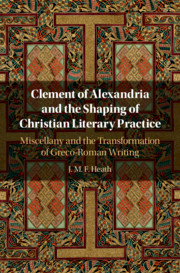 Clement of Alexandria and the Shaping of Christian Literary Practice
Clement of Alexandria and the Shaping of Christian Literary Practice Book contents
- Clement of Alexandria and the Shaping of Christian Literary Practice
- Clement of Alexandria and the Shaping of Christian Literary Practice
- Copyright page
- Contents
- Acknowledgements
- 1 Introduction
- 2 Clement’s Miscellanism and the Scholarly Trope of Christian Difference
- 3 Studying Ancient Miscellanism
- 4 Early Imperial Cultures of Miscellany-Making
- 5 Self-Introductions and Clement’s Miscellanistic Vocation
- 6 Miscellany Titles and Clement’s Divine Paratexts
- 7 The Miscellanist’s Trope of Deselecting Titles and Clement’s Conversion of Imagery
- 8 Muses in the Miscellanists’ Frame
- 9 Clement’s Theology of Hiddenness and the Logic of Christian Miscellanism
- 10 Mystery Initiation and Clement’s Literary Paideia
- 11 Poikilia
- 12 Conclusion
- Appendix The Literary Sequence of Protrepticus, Paedagogus, Stromateis (and Hypotyposeis)
- Bibliography
- Index
7 - The Miscellanist’s Trope of Deselecting Titles and Clement’s Conversion of Imagery
Published online by Cambridge University Press: 16 December 2020
- Clement of Alexandria and the Shaping of Christian Literary Practice
- Clement of Alexandria and the Shaping of Christian Literary Practice
- Copyright page
- Contents
- Acknowledgements
- 1 Introduction
- 2 Clement’s Miscellanism and the Scholarly Trope of Christian Difference
- 3 Studying Ancient Miscellanism
- 4 Early Imperial Cultures of Miscellany-Making
- 5 Self-Introductions and Clement’s Miscellanistic Vocation
- 6 Miscellany Titles and Clement’s Divine Paratexts
- 7 The Miscellanist’s Trope of Deselecting Titles and Clement’s Conversion of Imagery
- 8 Muses in the Miscellanists’ Frame
- 9 Clement’s Theology of Hiddenness and the Logic of Christian Miscellanism
- 10 Mystery Initiation and Clement’s Literary Paideia
- 11 Poikilia
- 12 Conclusion
- Appendix The Literary Sequence of Protrepticus, Paedagogus, Stromateis (and Hypotyposeis)
- Bibliography
- Index
Summary
Classical miscellanists invented the trope of listing in a preface other people's miscellany titles, which they were not choosing for their own work. By giving this impressionistic snapshot of a book culture, they could position their own work in relation to Greek and Roman literary heritage. Clement adapted this trope to name Hellenised points of entry into the Christian imaginary of his literary project. In the preface to Str. VI, he listed Meadows, Helicons, Honeycombs, and Peploi as titles of other people's works. These name significant domains in Clement's own imagery; if sophisticated readers trace his networks of imagery, they will find that these all begin as pagan motifs, but as they move through the Protrepticus, Paedagogus and Stromateis, they are gradually recast and reinvented as Christian. It may be that the Didaskalos evoked in the preface to Paed. I works in a similar way, as a miscellanistic non-title that highlights a domain of imagery in Clement's work, by which people are drawn closer to God.
- Type
- Chapter
- Information
- Clement of Alexandria and the Shaping of Christian Literary PracticeMiscellany and the Transformation of Greco-Roman Writing, pp. 166 - 203Publisher: Cambridge University PressPrint publication year: 2020
